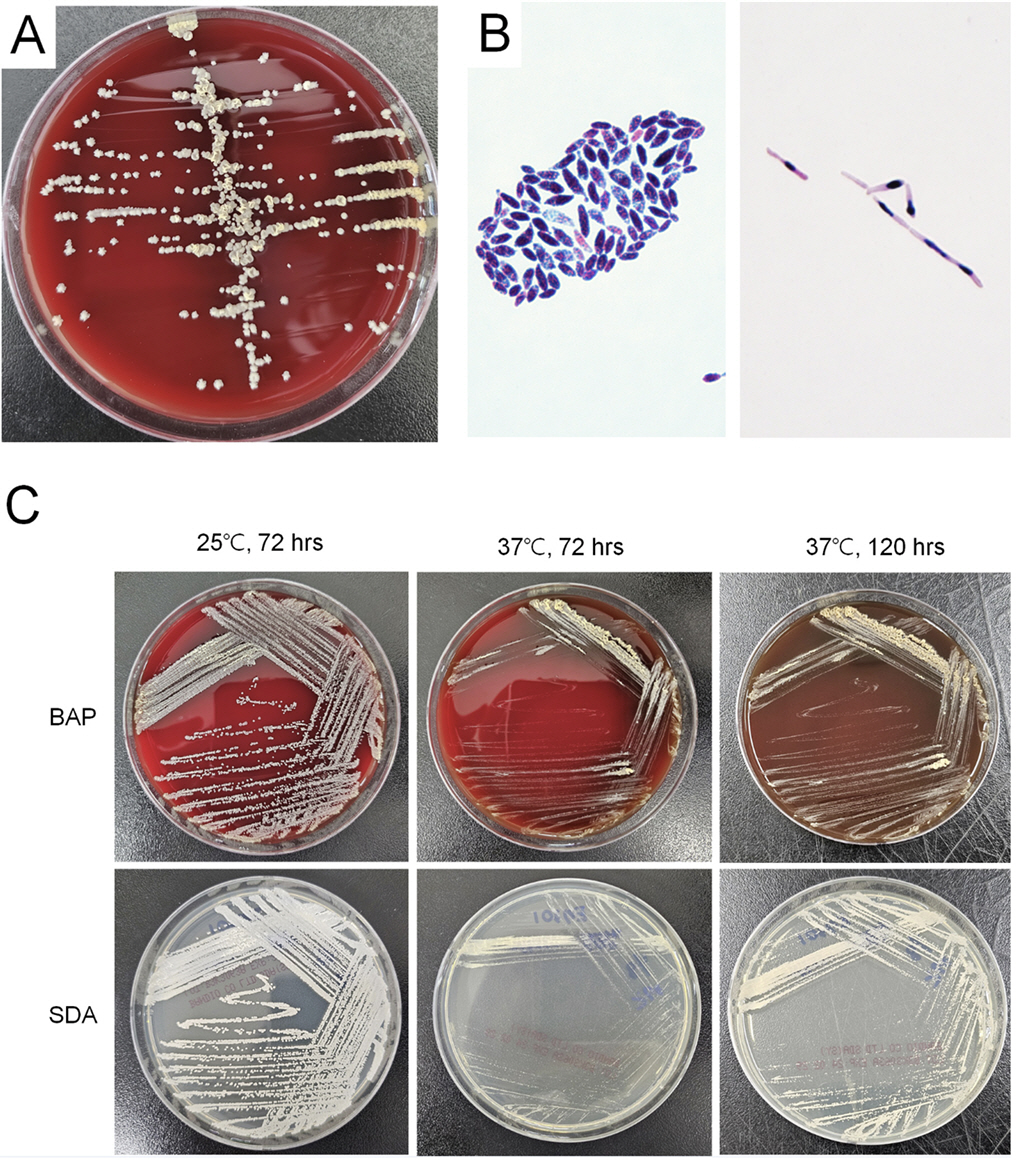Ann Clin Microbiol.
2024 Mar;27(1):31-37. 10.5145/ACM.2024.27.1.5.
Emergence of Vanrija humicola as a pathogen of urinary tract infections in Korea
- Affiliations
-
- 1Department of Laboratory Medicine, Asan Medical Center, University of Ulsan College of Medicine, Seoul, Korea
- KMID: 2556216
- DOI: http://doi.org/10.5145/ACM.2024.27.1.5
Abstract
- Vanrija humicola, a yeast belonging to Trichosporonaceae, is rarely pathogenic. All cases of isolation of V. humicola were retrospectively reviewed from 2021 to 2023. A total of four V. humicola were isolated from urine samples. Organisms cultured for 5 days at 25°C produced yellow, dry and cerebriform colonies, and were successfully identified as V. humicola using Bruker Biotyper MALDI-TOF. Two recent isolates were resistant to fluconazole, echinocandins, and flucytosine. In all 4 cases, V. humicola was sporadically isolated more than 14 days after admission. One case was presumed to be colonized. Of the other three cases that developed a urinary tract infection (UTI), only one with pancytopenia was treated for UTI by V. humicola with caspofungin, but expired 4 days later. V. humicola has emerged as a drug-resistant fungal pathogen of hospital-acquired UTI. Species identification and antifungal susceptibility testing of this organism are required for critical patients.
Keyword
Figure
Reference
-
1. Moore RT. Taxonomic proposals for the classification of marine yeasts and other yeast-like fungi including the smuts. Botanica Marina 1980;23:361-73.2. Alvarez Gasca MA, Arguero Licea B, Pliego Castaneda A, Garcia Tena S. Fungal agents isolated from cancer patients. Rev Latinoam Microbiol 1998;40:15-24.3. Morales-Lopez SE and Garcia-Effron G. Infections due to rare Cryptococcus species. A literature review. J Fungi 2021;7:279.4. Liu XZ, Wang QM, Goker M, Groenewald M, Kachalkin AV, Lumbsch HT, et al. Towards an integrated phylogenetic classification of the Tremellomycetes. Stud Mycol 2015;81:85-147.5. Schoch CL, Ciufo S, Domrachev M, Hotton CL, Kannan S, Khovanskaya R, et al. NCBI taxonomy: a comprehensive update on curation, resources and tools. Database (Oxford). 2020;2020:baaa062.6. Garcia-Martos P, Noval JF, Garcia-Tapia A, Marin P, Puerto JL, Sepulveda A. Susceptibility to antifungal agents of Cryptococcus species of clinical interest. Med Clin (Barc) 2002;119:2113.7. Nitzulescu V and Niculescu M. Cryptococcus species isolated from an ocular lesion. Arch Roum Pathol Exp Microbiol 1975;34:363-5.8. Ramli SR, Leong MC, Khaithir TM, Aziz MN, Loons LC, Rafia MH. Cryptococcus humicolus meningitis: first case report in Malaysia. Southeast Asian J Trop Med Public Health 2012;43:1212-7.9. Rogowska-Szadkowska D, Wiercinska-Drapalo A, Borzuchowska A, Prokopowicz D. Candida humicola infection of the central nervous system in an HIV-infected patient: a case report. Przegl Epidemiol 1997;51:465-9.10. Shinde SM, Vanarse KS, Pandit AN. Systemic humicolus cryptococcosis. Indian Pediatr 2004;41:1162-4.11. Sugita T, Takashima M, Nakase T, Ichikawa T, Ikeda R, Shinoda T. Two new yeasts, Trichosporon debeurmannianum sp. nov. and Trichosporon dermatis sp. nov., transferred from the Cryptococcus humicola complex. Int J Syst Evol Microbiol 2001;51:1221-8.12. Reddy AK, Brahmaiah U, Narayen N, Reddy RK, Reddy RK, Chitta M, et al. Is blood agar an alternative to sabouraud dextrose agar for the isolation of fungi in patients with mycotic keratitis. Int Ophthalmol 2013;33:251-4.13. Fisher JF, Sobel JD, Kauffman CA, Newman CA. Candida urinary tract infections--treatment. Clin Infect Dis 2011;52 Suppl 6:S457-66.14. Bernal-Martinez L, Gomez-Lopez A, Castelli MV, Mesa-Arango AC, Zaragoza O, RodriguezTudela JL, et al. Susceptibility profile of clinical isolates of non-Cryptococcus neoformans/ non-Cryptococcus gattii Cryptococcus species and literature review. Med Mycol 2010;48:90-6.
- Full Text Links
- Actions
-
Cited
- CITED
-
- Close
- Share
- Similar articles
-
- Host-Pathogen Interactions in Urinary Tract Infections
- Uropathogens Based on Antibiotic Susceptibility
- Changing Epidemiology of Extended Spectrum Beta-Lactamases Pathogen of Urinary Tract
- Treatment of urinary tract infections
- Clinical Guideline for the Diagnosis and Treatment of Urinary Tract Infections: Asymptomatic Bacteriuria, Uncomplicated & Complicated Urinary Tract Infections, Bacterial Prostatitis


